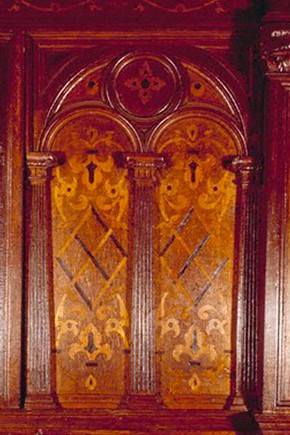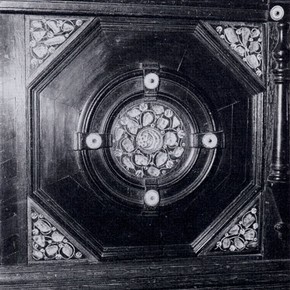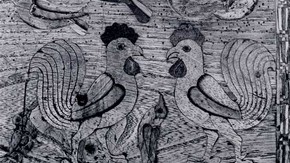Conservation Journal
July 1992 Issue 04
Furniture timbers
Wood is the neglected material of decorative art collections. There is no high-tech modern, non-destructive way of identifying the botanical species; a sample must be taken, sections prepared and a painstaking microscopical examination made.
Wood is a biological material consisting of several different types of cell, arranged in certain patterns which are fixed for each species or group of closely related species of tree. This pattern is like a fingerprint and may be used to identify the wood to its genus or sometimes to its species.
At least two hundred timbers have been used in European furniture and many more worldwide. The identification keys1,2 published by the Forest Product Research Laboratory (FPRL) contain 900 species; the more recent computer keys3 contain over 6,000 species. If a timber is not in the keys it can only be identified using experience and a sufficiently large reference collection of microscope slides, and not always then.
Books on furniture and museum labels often ignore the material that the object is made from or mention only the major carcase timbers. 'Rosewood inlaid with various other woods' is not very informative, indeed rosewood may come from India, South East Asia or South America; it may even be grained beech.
Why should we want or need to know which wood has been used? There are six main reasons:
- To catalogue and describe an object correctly.
- To establish provenance : certain timbers are of restricted geographical use.
- To establish date : the discovery of new continents, the establishment of trade links and fashion may all determine the possibility or likelihood of a certain timber being used at a particular date.
- To assist conservation: identification of the wood may help to explain why problems arise
- To assist practical conservation: in order to match the wood used to restore losses.
- To gain information on import trade : the accumulation of data will help to clarify many details the historical trade.
English 16th and 17th century furniture illustrates some of these points. Oak and walnut are the most important surviving timbers of the period but what we see today is the best, kept because of its quality and workmanship. Everyday furniture has not survived; broken, old-fashioned, worm-eaten, rotten from standing on damp floors and thrown away when something better could be afforded, most of the 16th and 17th century furniture of beech, elm, ash, alder and deal went onto the fire.
The earliest surviving inlays on quality furniture make use of native timbers. Tudor black and white inlays in oak are always said to be bog oak and holly. Of eight examined in this Department, seven are bog oak and poplar (Figure. 1). Bog oak is partially decayed oak preserved in peat bogs and stained black by the reaction of tannins in the wood and iron in the water. Poplar is pale cream coloured when fresh and very soft. The ease with which it could be cut would be similar to bog oak; holly is much harder. When the inlays had to be cut by hand, ease of working would be a major consideration. The eighth example has inlays of black composition, poplar and a brown wood identified as a species of Eucalyptus. The eucalypts are native to Australia, discovered in 1768, and therefore unlikely to appear in an early 17th century coffer. The coffer was probably 'improved' in the 19th century rather than deliberately faked. If the appropriate material had been used it would be assumed to be original inlay. Bog oak and poplar should be expected in Tudor inlays, eucalyptus most definitely should not.
A charming box of the early 17th century, (Figure. 2) was labelled 'Ash, inlaid with bog oak, pear and maple'; two right, two wrong. The box is constructed from elm, Ulmus procera, a wood rarely used in case furniture due to its propensity to warp. The light coloured inlays are maple, Acer sp., the black bandings and inlays bog oak. The most interesting discovery is Andaman padouk Pterocarpus dalbergioides, a deep purple-red wood seen in the geometrical bandings (with maple), the cock's wattles and the darker birds. It has faded to a warm reddish-brown. A species of padouk is said to have been imported in the 15th and 16th centuries as a dyewood, so its early appearance as a decorative inlay is not surprising.
In the second half of the 17th century a new style of decoration, of Dutch origin, has raised and fielded geometrical panels, mouldings and split baluster turnings. It may be entirely of oak, or have a variety of woods in the veneers and mouldings.
Of six pieces of furniture examined in detail, all have veneers of snakewood, Piratinera quianensis, a very hard and heavy West Indian wood of a rich red-brown colour with distinctive cloudy darker markings from which it takes its common name. Superficial examination of several other pieces suggest that snakewood was used in all of them.
The illustrated example in Figure. 3, the most decorative examined, has snakewood veneer in the raised fields of the octagons; it is combined with ebony, Diospyros ebenum, (from India or Ceylon), in the diagonal bandings and provides the rhomboid supports of the balusters which are turned in cherry, Prunus avium. Mother-of-pearl marquetry is combined with bog oak which is also used in the mouldings of the octagon and the backgrounds of the ivory discs.
It is interesting to see that the two hard, heavy exotic woods, ebony and snakewood, which would be difficult to work, are used for the veneer panels. Where intricate cutting or moulding is required the softer bog oak is used. Snakewood virtually disappears with the decorative style and may be considered diagnostic of a genuine 17th century piece... the Age of Snakewood.
These three examples illustrate our ignorance of 16th and 17th century furniture woods. The desire for decorative and colourful inlay was first fulfilled with native bog oak and poplar but by the turn of the century, increasing numbers of finely coloured and figured woods were being imported from the East, the Mediterranean, the West Indies and North America.
References
1. Brazier, J. D. and Franklin, G. L., 'Identification of Hardwoods. A Microscope Key,' Forest Product Research Bulletin, No 46, HMSO, 1961.
July 1992 Issue 04
- Editorial
- Furniture timbers
- Data from the ether
- A question of research
- The technical examination & conservation of painted furniture
- Interim meeting of the ICOM 'Graphic Documents' working group held at the V&A
- A review of the Institute of Paper Conservation Conference, Manchester, April 1st - 4th 1992
- A review of 'The Imperfect Image'
- Disaster reaction planning progress
- Corrosion of metals associated with wood


